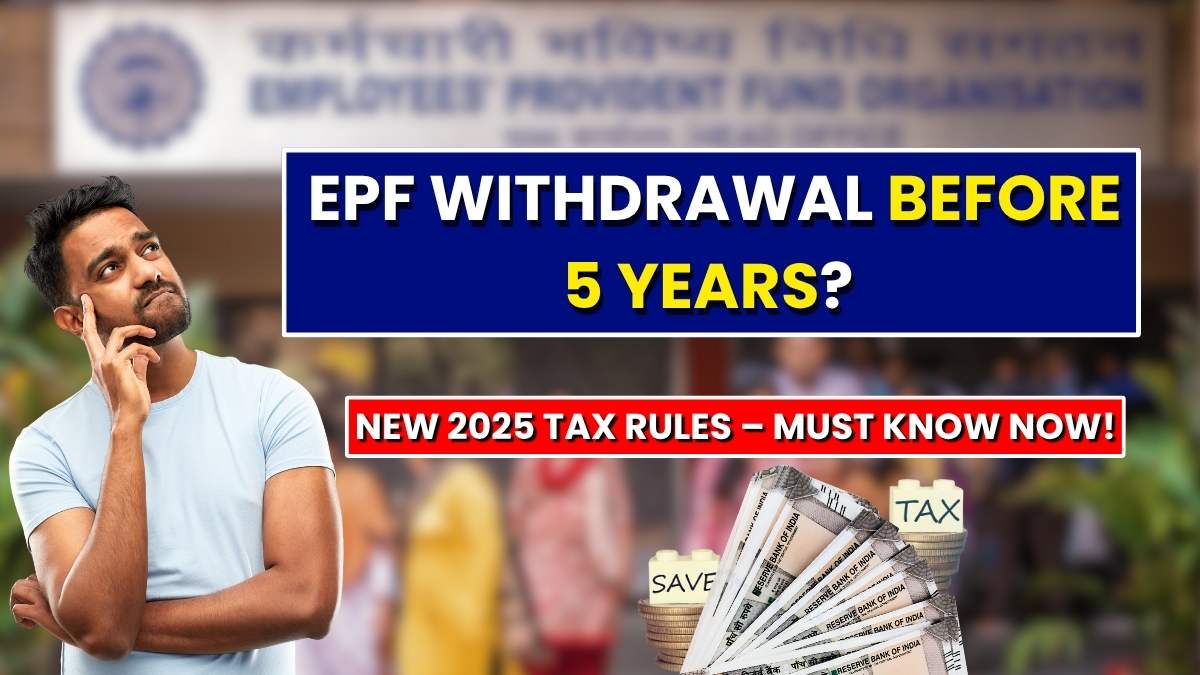Employees’ Provident Fund (EPF) is one of the most important savings tools for long-term financial security. Many people contribute to it without thinking about how or when they might withdraw it. But sometimes, life situations like changing jobs, emergencies, or personal needs make early withdrawal tempting.
If you’re considering withdrawing your EPF before completing 5 years of continuous service, it’s important to understand the tax implications. In 2025, there are clear rules about what is taxable, when TDS applies, and the exceptions that let you withdraw without paying tax. Knowing these can save you a lot of money and prevent surprises at tax time.
When is EPF withdrawal before 5 years taxable?
If you withdraw your EPF before completing 5 years of continuous service, the withdrawal can be taxable. How much tax you pay depends on which parts of your EPF you withdraw: your contribution, your employer’s contribution, and the interest earned.
For example, if you have worked for 3 years and withdraw ₹2 lakh, the employer’s contribution and interest are taxed as income. Your own contribution may also be taxable if you claimed deductions under Section 80C while contributing. TDS is typically applied if the withdrawal exceeds ₹50,000.
How 5 years of continuous service is counted
The 5-year clock is based on continuous service:
- Transferring your EPF account when changing jobs preserves your service period.
- If you withdraw instead of transferring, the service period resets, making the withdrawal taxable.
- Even a few days short of 5 years counts as less than 5 years, and tax rules will apply.
Cases where early withdrawal can be tax-free
There are exceptions allowing tax-free withdrawal even before 5 years:
- Leaving employment due to illness or permanent incapacity.
- Employer shuts down operations or leaves EPF coverage.
- Transfer of EPF account instead of withdrawal when switching jobs.
Planning tips for EPF withdrawal
- Submit Form 15G or 15H if your total income is below taxable limits to avoid TDS.
- Always transfer your EPF account when changing jobs to preserve continuous service.
- Track exact service dates carefully; even a few days short can trigger tax.
- If possible, wait until completing 5 years to withdraw tax-free.
Early vs late withdrawal comparison
| Scenario | Service Duration | Tax Implication | TDS Applied |
|---|---|---|---|
| After 5 years | 5 years or more | Fully tax-free | No |
| Before 5 years | Less than 5 years | Taxable unless exception applies | Yes, if > ₹50,000 |
| Exception cases | Less than 5 years | Tax-free if qualifying condition met | No |
Key takeaways
- Withdrawals before 5 years are generally taxable.
- Transfer your EPF account when changing jobs to maintain continuity.
- Check for exceptions to avoid paying tax unnecessarily.
- Using Form 15G/15H can prevent TDS if income is low.
Careful planning can save you tax and protect your retirement savings.
FAQs
1. Can I withdraw EPF tax-free if I leave after 4 years?
No, withdrawals before 5 years are usually taxable unless an exception applies.
2. Does changing jobs reset the 5-year clock?
No, transferring your EPF account preserves continuity. Withdrawing resets the clock.
3. Is TDS always deducted for early withdrawal?
TDS applies if the withdrawal exceeds ₹50,000. Smaller withdrawals may not have TDS, but tax may still apply.
4. Can Form 15G/15H prevent tax on early withdrawal?
These forms prevent TDS if income is below taxable limits, but the withdrawal may still be taxable depending on service period and contributions.
5. What happens if my employer shuts down before 5 years?
You can withdraw EPF tax-free even before 5 years if the employer ceases operations or leaves EPF coverage.



